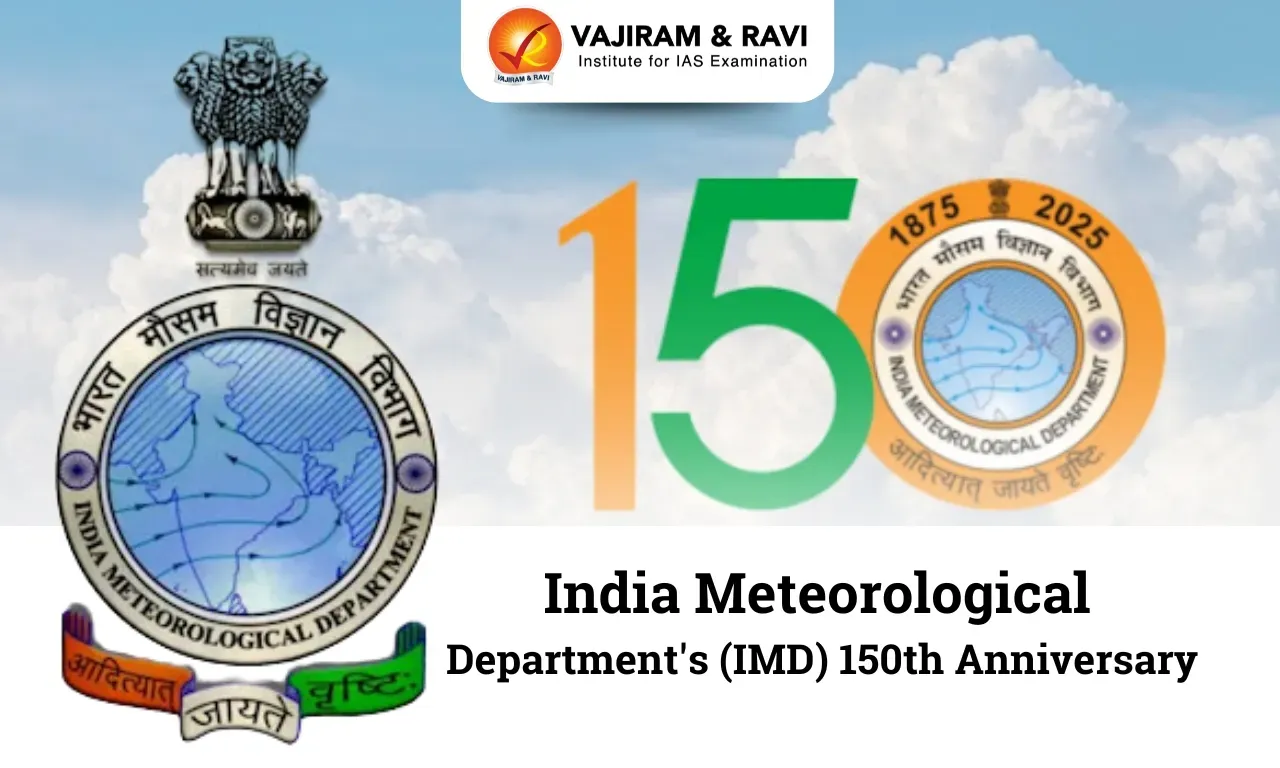What’s in today’s article?
- Why in News?
- India Meteorological Department (IMD)
- Improvements in Forecasting by IMD
- Towards Zero-Error Forecasting by IMD
- From Forecasting to Weather Management
Why in News?
The India Meteorological Department (IMD) celebrated its 150th anniversary on January 15, 2025.
India Meteorological Department (IMD)
- About
- The IMD is a government agency that is responsible for weather forecasting, seismology, and meteorological observations.
- It was established in 1875 and is headquartered in New Delhi.
- The IMD has hundreds of observation stations across India and is the country’s National Meteorological Service.
- Madate
- The IMD’s mandate includes:
- Observations: Taking meteorological observations
- Forecasting: Providing current and forecast information for weather-dependent activities
- Warnings: Giving warnings against severe weather phenomena
- Statistics: Providing met-related statistics
- Research: Engaging in research
- The IMD’s mandate includes:
- Nodal Ministry
- Ministry of Earth Sciences of the Indian Government
Improvements in Forecasting by IMD
- Enhanced Observation Network
- Doppler Weather Radars: Increased from 15 in 2014 to 39 in 2024.
- Automatic Weather Stations: Increased from 675 to 1,208.
- High Wind Speed Recorders: Increased from 19 to 37.
- Rainfall Monitoring Stations: Increased from 3,995 to 6,095.
- Introduction of New Systems:
- Seven automated weather observing systems.
- Heliport weather observing systems.
- Satellite Monitoring:
- Two geostationary satellites, INSAT 3DR and 3DS, monitor weather round-the-clock (replacing INSAT 3D in 2014).
- Improved Weather Model Resolution
- Medium-range forecast resolution improved from 25 km to 12 km.
- Better resolution enables forecasting for smaller areas with greater accuracy (12 km x 12 km grids).
- Significant Gains in Forecast Accuracy
- Heatwave Prediction: 95% accuracy up to two days in advance (compared to 50% in 2014).
- Thunderstorm Detection: Hourly detection accuracy improved to 86% (from 50% in 2017).
- Heavy Rainfall Prediction: Accuracy up to three days in advance increased to 78% (from 50% a decade ago).
- Cyclone Track Prediction: Accuracy improved by 35-40%, leading to zero loss of human lives.
Towards Zero-Error Forecasting by IMD
- Vision Document 2047
- Objective: To make India climate-smart and weather-ready by 2047, the centenary year of independence.
- Roadmap: Upgradation of IMD’s capabilities over the next two, five, 10, and 22 years.
- Forecast Accuracy Goals
- Zero-Error Block-Level Forecasts:
- Aim: Accurate severe weather predictions up to three days in advance by 2047.
- Accuracy Targets for Extended Forecasts:
- Five-day advance forecasts: 90% accuracy.
- Weekly forecasts: 80% accuracy.
- 10-day advance forecasts: 70% accuracy.
- Zero-Error Block-Level Forecasts:
- Enhanced Monitoring and Warnings
- Goal: Eliminate human fatalities from severe weather events within 20 years.
- Improved Weather Model Resolution
- Current resolution: 12 km.
- Target resolution: 5-6 km for hyper-localised weather forecasts at the village panchayat level.
From Forecasting to Weather Management
- Transitioning to Weather Management
- IMD aims to evolve from a weather forecaster to a weather manager, focusing on managing rain, hail, and fog, which cause significant disruptions.
- Mission Mausam, inaugurated by PM Modi, lays the foundation for weather modification and management.
- Key Initiatives under Mission Mausam
- Cloud Chamber at IITM, Pune:
- First-of-its-kind in India.
- Aims to enhance understanding of cloud physics.
- Focus on perfecting cloud seeding to modify precipitation through human interventions.
- Advanced Observation Systems
- Technological Innovations:
- Use of unmanned aerial vehicles (UAVs), automated weather stations, and IoT-based sensors for data collection in remote areas.
- Establishment of regional climate reference stations and smaller Meteorological (Met) centres.
- Upper Atmosphere Monitoring:
- Round-the-clock monitoring at 100 km x 100 km grids using satellites, aircraft-based profilers, radars, and wind profilers.
- Enhanced Forecasting Accuracy
- Goal: 100% detection capabilities for all weather phenomena.
- Improved data collection and analysis to minimise forecasting errors and enhance weather model performance.
- Cloud Chamber at IITM, Pune:
Q.1. What are the key advancements made by IMD in weather forecasting over the last decade?
Over the last decade, IMD has improved forecast accuracy by 40%, increased Doppler weather radars to 39, and reduced weather model resolution to 12 km. This has enhanced prediction accuracy for severe weather events like heatwaves, thunderstorms, and cyclones.
Q.2. How does Vision 2047 aim to transform IMD’s forecasting capabilities?
Vision 2047 aims for zero-error forecasts for severe weather up to three days in advance, accuracy of 90% for five-day forecasts, and hyper-localised predictions with a resolution of 5-6 km at the village level.
Last updated on December, 2025
→ Check out the latest UPSC Syllabus 2026 here.
→ Join Vajiram & Ravi’s Interview Guidance Programme for expert help to crack your final UPSC stage.
→ UPSC Mains Result 2025 is now out.
→ UPSC Notification 2026 is scheduled to be released on January 14, 2026.
→ UPSC Calendar 2026 is released on 15th May, 2025.
→ The UPSC Vacancy 2025 were released 1129, out of which 979 were for UPSC CSE and remaining 150 are for UPSC IFoS.
→ UPSC Prelims 2026 will be conducted on 24th May, 2026 & UPSC Mains 2026 will be conducted on 21st August 2026.
→ The UPSC Selection Process is of 3 stages-Prelims, Mains and Interview.
→ UPSC Result 2024 is released with latest UPSC Marksheet 2024. Check Now!
→ UPSC Prelims Result 2025 is out now for the CSE held on 25 May 2025.
→ UPSC Toppers List 2024 is released now. Shakti Dubey is UPSC AIR 1 2024 Topper.
→ UPSC Prelims Question Paper 2025 and Unofficial Prelims Answer Key 2025 are available now.
→ UPSC Mains Question Paper 2025 is out for Essay, GS 1, 2, 3 & GS 4.
→ UPSC Mains Indian Language Question Paper 2025 is now out.
→ UPSC Mains Optional Question Paper 2025 is now out.
→ Also check Best IAS Coaching in Delhi

















